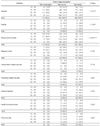Abstract
Objectives
Self perceived body image among women is drawing a lot of attention in Korea due to their unhealthy weight control behaviors. To determine the relationship between self-perceived body image and dietary behaviors among Korean women, the discrepancy between actual body size and body image perception, weight control behaviors were assessed based on age groups using the 2010 KNHANES data.
Methods
A total of 1,747 subjects were selected after eliminating those of likely changing their diet recently using the 2010 KNHANES data. The subjects were divided into 3 groups, self-underweight, self-normal, and self-obese according to their perception of body image. The BMI and weight control behaviors were assessed based on age groups according to the body image perception.
Figures and Tables
References
1. Ahn Y, Kim H, Kim K. A study on weight control, nutritional knowledge, dietary attitudes and eating behaviors among high school female students. Korean J Community Nutr. 2006; 11(2):205–217.
2. Chin JH, Chang KJ. College students' attitude toward body weight control, health-related lifestyle and dietary behavior by self-perception on body image and obesity index. J Korean Soc Food Sci Nutr. 2005; 34(10):1559–1565.
3. Cho YJ. The comparative study on perception and satisfaction of somatotype of university woman students. J Korean Home Econ Assoc. 2003; 41(11):73–80.
4. Choi IS, Ro HK. A comparison study on middle school students of Gwangju and Jeonnam in terms of dietary behavior, body perception and weight control concerns according to BMI. J Korean Soc Food Sci Nutr. 2010; 39(3):383–391.
5. Chung SK. Weight control practices and body image of female college students. J Korean Soc Health Educ Promot. 2001; 18(3):163–175.
6. Her ES, Kang HJ, Lee KH. The factors associated with weight control experiences among adolescents - Based on selfesteem, body-cathexis, attitudes toward the body, anthropometric characteristics and perceptions of body shape -. Korean J Community Nutr. 2003; 8(5):658–666.
7. Hong EK, Park SB, Shin YS, Park HS. Body image perception and self-reported weight control activities in adolescent girls. J Korean Acad Fam Med. 1997; 18(7):714–721.
8. Hong MS, Pak HO, Sohn CY. A study on food behaviors and nutrient intakes according to body mass index and body image recognition in female university students from Incheon. Korean J Food Nutr. 2011; 24(3):386–395.
9. Im ES, Myeong SJ, Kang HY. Body image, weight-control self-efficacy, body mass index, and body weight control behavior of high school girls. J Korean Soc School Health. 2013; 26(3):195–204.
10. James DC. Gender differences in body mass index and weight loss strategies among african americans. J Am Diet Assoc. 2003; 103(10):1360–1362.
11. Janssen I, Katzmarzyk PT, Ross R. Body mass index, waist circumference, and health risk: evidence in support of current national institutes of health guidelines. Arch Intern Med. 2002; 162(18):2074–2079.
12. Kim BS, Lee YE. The relationship of food behaviors with body image and BMI of female college students in Jeonbuk province. Korean J Hum Ecol. 2000; 9(2):231–243.
13. Kim GS, Kang YJ. The effect of female adolescent bodyrelated variables, self-esteem and internal control on eating disorder behavior. J Korean Home Manage Assoc. 2007; 25(3):77–87.
14. Kim MO, Chang UJ. A study on the perception of obesity by age and the attitude toward weight control. Korean J Food Nutr. 2009; 22(1):110–122.
15. Kim OS, Kim KH. Weight, self-esteem, and depression in high school and college females. J Korean Acad Adult Nurs. 2000; 12(3):396–406.
16. Kim YK, Shin WS. A comparison study on perception of body image and dietary habits of high school students between urban and rural areas. Korean J Community Nutr. 2008; 13(2):153–163.
17. Koo JO, Park S. Analysis of BMI, body composition, weight control, dietary behaviors of adult women. Korean J Community Nutr. 2011; 16(4):454–465.
18. Lee HJ, Choi MR, Koo JO. A study of body image, weight control and dietary habits with different BMI in female high school students. Korean J Community Nutr. 2005; 10(6):805–813.
19. Lee JS, Ha BJ. A study of the dietary attitude, dietary selfefficacy and nutrient intake among middle school students with different obesity indices in Gyeong-Nam. Korean J Community Nutr. 2003; 8(2):171–180.
20. Lee JS, Yun JW. A study on perception about body image, dietary attitude, dietary self-efficacy and nutrient intake of high school students in Busan. J Korean Soc Food Sci Nutr. 2003; 32(2):295–301.
21. Lim ET, Kim Y. The relationship between the prevalence of constipation and beverage intake of female high school students in Seoul. Korean J Community Nutr. 2003; 8(6):856–866.
22. Lobstein T, Baur L, Uauy R. Obesity in children and young people: A crisis in public health. Obes Rev. 2004; 5(s1):4–104.
23. Oh DN, Kim EM, Kim SH. Weight control behaviors and correlates in Korean adolescents. J Korea Contents Assoc. 2013; 13(3):218–228.
24. Ryu HK, Park JA. Perception of body image, eating disorder, eating behaviors and subjective health status of female high school and college students in Daegu area. Korean J Community Living Sci. 2002; 13(3):69–80.
25. Suh YS, Kang HJ, Chung YJ. Difference in weight control status and eating behavior between dissatisfied and satisfied female high school students regarding their own body shape. Korean J Food Cult. 2011; 26(4):354–363.
26. Won HS, Han SS, Oh SY, Kim HY, Kim WK, Lee HS, Jang YA, Cho SS, Kim SH. Guidelines of body mass index in Korean childhood and adolescent obesity and relationship with physical strength. Korean J Nutr. 2000; 33(3):279–288.
27. Yeon JY, Hong SH, Bae YJ. A study on nutritional status and dietary quality of university students by body image. Korean J Community Nutr. 2012; 17(5):543–554.
28. Yoo WS, Kim Y. A study on eating disorders and it's related factors in high school girls. Korean J Community Nutr. 2004; 9(3):274–284.




 PDF
PDF ePub
ePub Citation
Citation Print
Print








 XML Download
XML Download